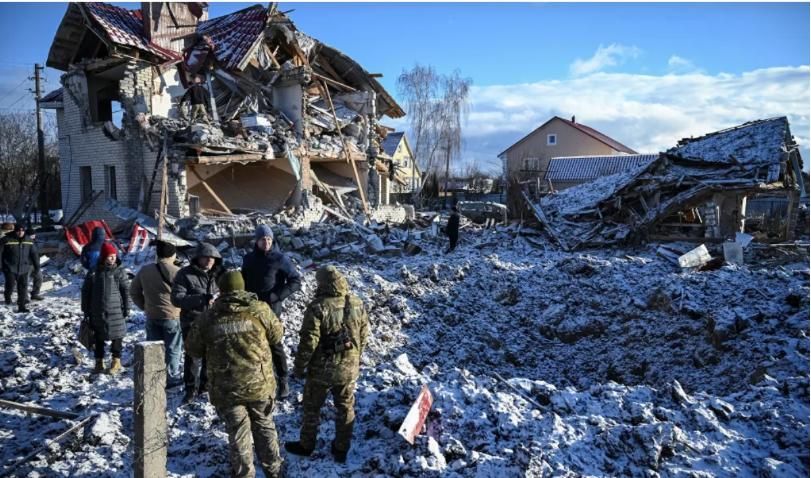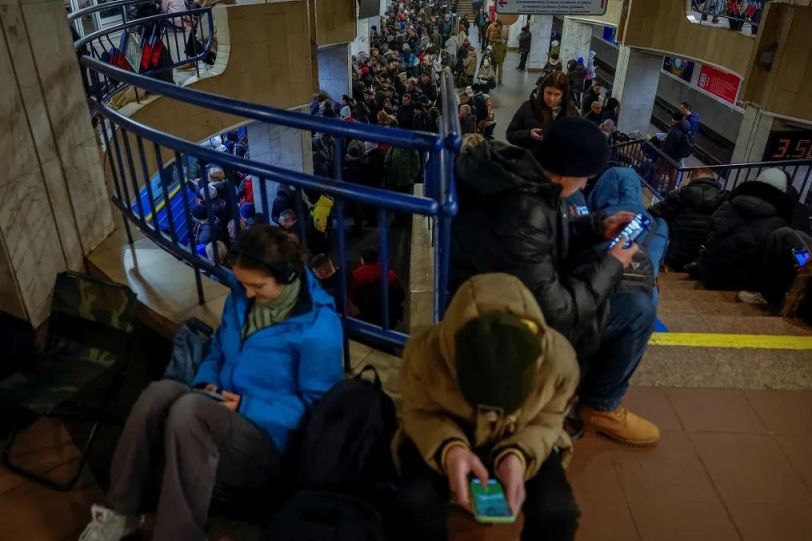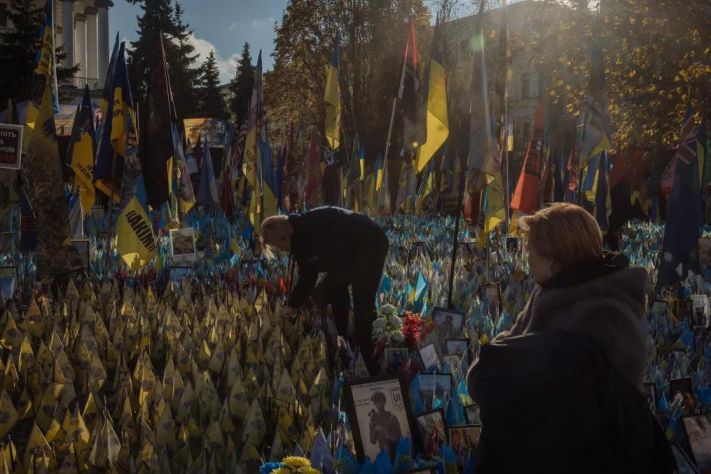By Eric Vandenbroeck and co-workers
Russia Vows Retaliation
Recently we posted an
article about the real risk of escalation in Ukraine.
Russia now has vowed retaliation after claiming to have shot down eight US-made ATACMS
missiles fired by
Ukraine on Saturday morning.
Moscow sees the use
of such missiles, which have a range of up to 300 kilometers (186 miles), as a
major escalation.
The country’s air
defenses shot down the eight ballistic missiles alongside 72 aircraft-type
unmanned aerial vehicles (UAVs), Russia’s Ministry of Defense said. It added
that “these actions by the Kyiv regime, which is supported by Western curators,
will be met with retaliation.”
The statement said
several drones were destroyed in the Leningrad region in the north-west and one
in Kursk, where Ukraine launched a surprise attack late last summer.
The outgoing US
President Joe Biden approved
Kyiv’s use of ATACMS in November – saying in part it was in response to Russia
expanding the conflict by deploying North Korean troops.
A Form of Russian Collapse?
Although Russia is still growing in GDP, the economy is not in a firm
shape. The inherently flawed economy could not sustain long-term warfare
for the Kremlin. Before the war, Russia relies on the export of energy and
raw materials for financial resources. Indeed, there has been a trade
surplus for the Russians over the years; the fluctuating international energy
prices still crucially impact the annual income of Russia. The 2014 oil price dip and its aftermath prove Russia’s insatiable
income status as the Russian economy suffered a recession. Russia’s reliance on imported manufactured goods indicates an
unbalanced industrial distribution since the Soviet times. Moscow’s
economic structure is not suited for a long war.
Also, the cost of
modern warfare was a bill Moscow could not pay for. One of the most
prominent examples in this case is Russia’s military actions in 2015 in
Syria. The war has quickly drained Russia’s storage of ammunition. The
cost itself is four million
US dollars per
day. This is just the Air Force operation on a relatively smaller
scale. The bill for the current war in Ukraine could only be
significantly more enormous as more troops and more operations are required on
the frontline.
The fragile economy
also reflects on the military expenditures. Russia’s military expenditure
remained at a low level until 2022. The low spending meant that some vital
upgrades could not be fully initiated. The most advanced tanks, such as
T14, were only considered for
deployment until
the beginning of the Russia-Ukraine war. The Russian Navy and Air Force
are also falling behind in equipment upgrades. Looking at the Victory Day
parade in the past years, it becomes apparent that Russia lacked the storage
and production capacity to bulk up its military. This still relates to the
flaws embedded in Russia since the beginning.
The sanctions proved
to have a long-term effect on Moscow’s economy. The initial impact of
sanctions has been questioned since all the economic indicators were stable in
Russia. Yet, the long-term effect of the sanctions only started to show
much later. Russia’s exports have declined significantly. Its oil and
natural resources must be sold to other buyers below the market
prices. These methods
strained Russia’s ability to generate revenue. Meanwhile, Russia’s access
to foreign currency was also restrained as sanctions were introduced, forcing
the Moscow Exchange to suspend trading in Euros and US Dollars. The
sanctions limited Russia’s ability to mobilize financial resources to go into
the war.
The threats of
secondary sanctions also forced other countries to limit their trade relations
with Russia. Chinese banks, for example, have already stopped
issuing US dollar
letters of credit to Russians since the beginning of the war. Smaller Chinese
banks have also stopped
accepting transactions
based on the Chinese Yuan with Russia. These are all based on the fear of
secondary sanctions from the US. Russia’s trade with Central Asia is also
under tight scrutiny. Kazakh and Uzbek companies have already been
hit by sanctions related to
Russia. The tight scrutiny also meant that Russians faced more
difficulties using
Central Asian banks for transactions. Russia’s international trade channel
shrinks further as more parties collaborate with the sanctions.
The spilling effect
of war itself further evaporates Russia’s thin economic resources. These
spilling effects include the lack of manpower and uncontrolled government
spending. These effects could damage the Russian economy both now and in
the future.
The uncontrolled
government spending makes the Russian economy grow on the surface. The
military expenditure has increased significantly since the war started. Defense
spending could make up to 40% of Russia’s expenditure in 2025. The
government also provided generous subsidies to companies, from transportation to oil refineries, to sustain the economic activity. Moscow’s
transfer payment to other parts of the nation is also significant. For
regions like Chechnya, Moscow subsidies are the
lifeline of regional
fiscal capacity. All of these expenses eat up Russia’s vital economic
resources. Moscow has already increased
taxes to fund its
war. The irresponsible spending could only drag Russia into a financial
quagmire.
The spilling effect
of war also led to a lack of manpower in the economy. Sustaining an
economy requires manpower. As Russia reports that 73% of the companies
are experiencing labor shortages, the future production capacity and growth become
exceptionally uncertain. Since the beginning of the war, almost one
million Russians left the
country to live
abroad. These Russians are highly educated and hold key knowledge for the
function of the economy.
Putin and the Moscow
government wanted to create the image that Russia is still that polar bear that
the world feared for years. However, the war in Ukraine revealed the
actual color of the Russians. Moscow’s money bag is far shallower than the
world thought. From the beginning, the flawed economy and the long-lasting
effects of the sanctions had already hindered Russia’s potential in the
war. The impact of war on the economy almost announced the doom of
Russia’s economy. The numbers on the surface may seem stable, but Moscow
may undergo an economic collapse soon.
Russia’s new nuclear-capable ballistic missile
Russian
President Vladimir Putin has
threatened to respond to Ukrainian strikes using ATACMS with Russia’s new
nuclear-capable ballistic missile “Oreshnik.”

Residents and bomb
squad members stand in front of a house destroyed by a Russian missile strike
on Saturday.
Last month, Putin
suggested that it could be fired at the capital Kyiv as a test of
Western-supplied air defense systems.
The first and only
launch of the experimental weapon targeted Ukraine’s Dnipro region on the
morning of November 21.
The Ukrainian drone
attacks forced temporary restrictions to be introduced at an airport in St.
Petersburg, Russian state media agency TASS reported.
The governor of
Leningrad oblast, Aleksandr Drozdenko, said in a statement on Telegram that the
“night and morning of January 4 were record-breaking in terms of the number of
UAVs destroyed,” with four shot down over his region.
A Ukrainian security
official, Andrii Kovalenko, said a seaport in Leningrad was targeted, calling
it an “instrument of economic and military survival for Russia in isolation.”
Meanwhile, Russia
launched a total of 81 drones at Ukraine overnight on Friday into Saturday,
according to Ukraine’s Air Force Command, including Iranian-made Shahed drones
and “various types of imitation drones.”
Ukrainians shelter in a metro station in Kyiv during
Russia's large-scale missile attack.

Some 34 Shahed attack
UAVs and other types of drones were downed, according to a statement, although
the downed drones caused damage in the Chernihiv and Sumy regions.
Ukraine enters the
year on the back
foot in the conflict,
which began in February 2022, with Russia making gains on the eastern
frontlines.
Russia’s defense
ministry said on Saturday that its forces had taken control of the village of
Nadiya in Ukraine’s eastern Luhansk region. Donetsk, the hub of Pokrovsk is
under growing Russian pressure as Ukrainian forces lose ground to the south and
east of the town.
Ukraine is also
concerned that the incoming Trump administration could cut vital military aid;
Trump himself has vowed to end the conflict.
Over 1,000 days of
war, Russian President Vladimir Putin has repeatedly warned Kyiv’s Western allies of
dire – potentially nuclear – consequences if they “escalate” the war by
giving Ukraine the weapons it needs to defend itself.
Ukrainians attend a memorial in Kyiv

Putin’s threats
became even fiercer this month after the Biden administration finally permitted
Kyiv to launch longer-range American weapons at targets deep inside Russia. In
response, Putin updated Russia’s nuclear
doctrine and fired a
new, nuclear-capable
ballistic missile at
Ukraine. The message was taken as a clear threat to Ukraine’s backers: Don’t
test us.
For updates click hompage here